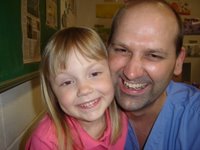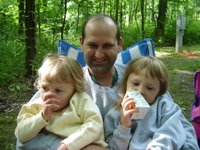Reprinted from: www.marrow.org -
ABCs of Marrow or Blood Cell DonationWhat is a marrow or blood cell transplant?A marrow or blood cell transplant is a potentially life-saving treatment for patients with leukemia, lymphoma, and other blood diseases. A transplant replaces a patient's unhealthy blood cells with healthy blood-forming cells from a volunteer donor. Patients who do not have a suitably matching donor in their family may search the NMDP donor Registry for a donor. The three sources of blood-forming cells are marrow, blood-forming cells collected from the blood (called a PBSC donation) and umbilical cord blood.
How are patients matched with donors?Blood or cell samples from adult donors or cord blood units are tested, and the tissue or cell type is added to the NMDP Registry. Doctors can search this Registry when they need to find a donor whose tissue type matches their patient's.
How does a person's race or ethnicity affect matching? Because tissue type is inherited, patients are most likely to match someone of their same race and ethnicity. There is a special need to recruit more donors who identify themselves as: Black or African American, American Indian or Alaska Native, Asian, Hawaiian or Other Pacific Islander, Hispanic or Latino.
How are blood-forming cells collected?Marrow donation is a surgical procedure performed in a hospital. While the donor receives anesthesia, doctors use special, hollow needles to withdraw liquid marrow from the donor's pelvic bones. Many donors receive a transfusion of their own previously donated blood. A donor's marrow is completely replaced within four to six weeks.
PBSC donation takes place at an apheresis center. To increase the number of blood-forming cells in the bloodstream, donors receive daily injections of a drug called filgrastim for five days before the collection. The donor's blood is then removed through a sterile needle in one arm, passed through a machine that separates out the cells used in transplantation, and the remaining blood is returned through the other arm.
Cord blood is collected from the umbilical cord after a baby's birth. The cord blood is taken to a cord blood bank where it is tested. Cord blood units that meet eligibility standards are frozen and stored for future use. The collection does not pose any health risk to the mother or baby, and does not affect the birth process in any way.
Does donating hurt? What are the side effects?Marrow donors can expect to feel some soreness in their lower back for a few days or longer. Donors also have reported feeling tired and having some difficulty walking. Most donors are back to their usual routine in a few days. Some may take two to three weeks before they feel completely recovered.
PBSC donors report varying symptoms including headache, bone or muscle pain, nausea, insomnia and fatigue while receiving injections of filgrastim. These effects disappear shortly after collection. During the collection, donors may experience a tingling feeling or chills. These effects go away shortly after donating. When asked about their discomfort, most donors are quick to point out that it was worth it to help save a life, and they would be willing to do it again.
How does a patient receive a transplant?After a patient undergoes chemotherapy and/or radiation treatment to destroy their diseased marrow, the healthy donor cells are given directly into the patient's bloodstream. The cells travel to the marrow, where they begin to function and multiply.
How does a person become a volunteer donor?Potential donors must be between the ages of 18 and 60 years old and meet health guidelines. A small blood sample or swab of cheek cells is taken and tested to determine the donor's tissue type. Potential donors also complete a brief health questionnaire and sign a consent form to have their tissue type listed on the Registry.




